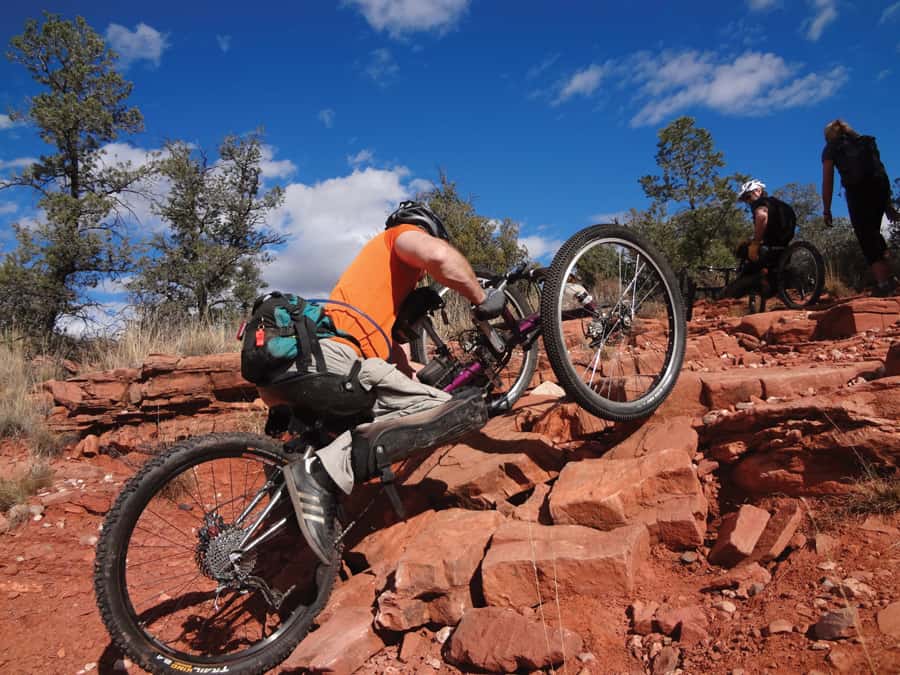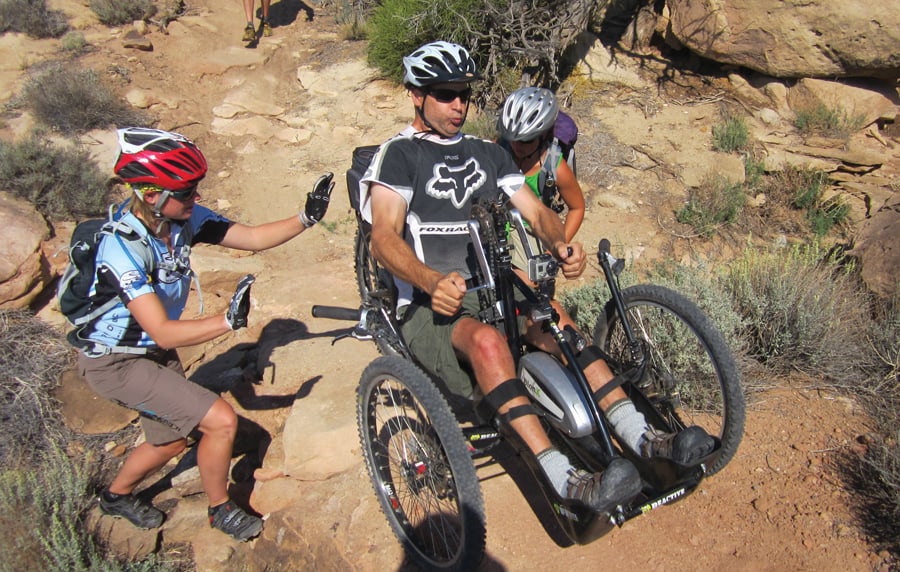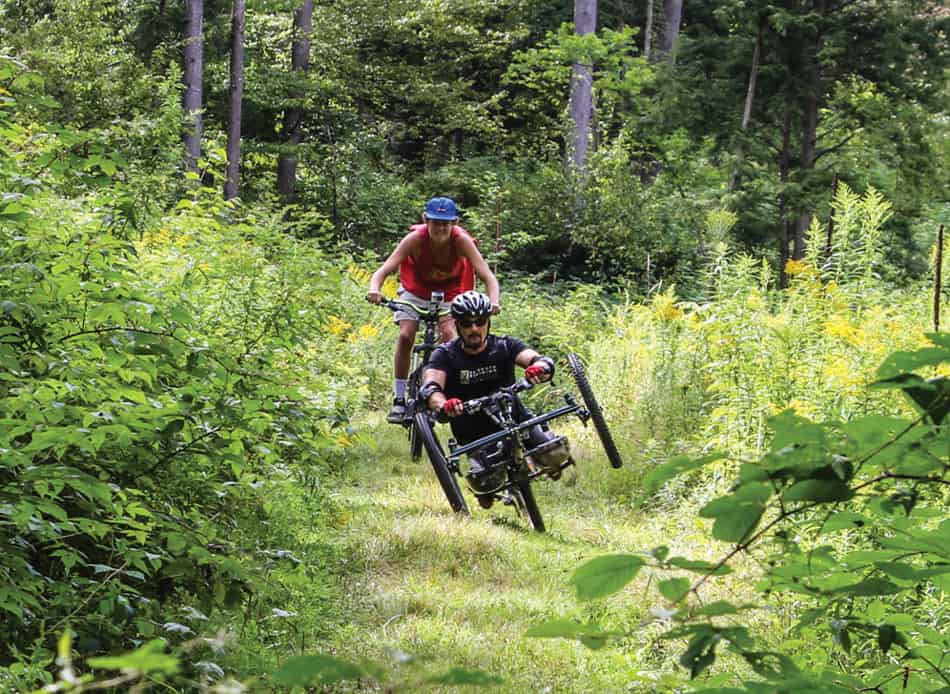
No longer do quads and others with limited arm strength need to sit by and watch as paras crank their mountain bike handcycles up steep slopes. Power-assist options are opening up the rugged outdoors like never before.

It’s the final day of Moab Mania — the annual six-day adaptive mountain bike clinic put on by Telluride Adaptive Sports Program — and Jake O’Connor has a satisfied grin as he watches C6-7 quad Pat Dougherty crank his Nuke off-road handcycle up a steep section of the famous Slickrock mountain bike trail. As owner, designer and manufacturer of ReActive Adaptations, an adaptive equipment company that specializes in off-road handcycles, O’Connor designed and built all of the client’s bikes at this year’s event.
Riding with other wheelers, coaching and watching them push his handcycles into previously inaccessible terrain and wilderness areas is O’Connor’s payoff for a job well done.
Riding with and coaching people on picking the right line and cranking a steep section of slick rock is also fitting for 37-year-old O’Connor. His original passion was rock climbing, and the mountains were his playground. Every moment he wasn’t working construction or finishing his degree in construction management was spent climbing. He joined the rolling ranks in 2001when a wall fell on him while working on a construction site, resulting in T11-12 complete paralysis.

Within 11 months of his injury, he finished his degree and landed a construction management job with JE Dunn Construction — which meant moving from Colorado to Kansas City and overseeing everything from building Casinos and power stations to prisons.
When not working, O’Connor immersed himself in racing handcycles. He was introduced to off-road handcycling in 2005 when he got a chance to try a One-Off handcycle, the first true “mountain bike” handcycle. “I had been interested in them for years. When I got a chance to try a used one that was for sale, I was hooked. I bought it that day,” he says. “The designer and manufacturer of the One-Off, Mike Augspurger, created a phenomenal bike that changed the world.” And the One-Off changed O’Connor’s focus from road cycling to mountain biking. Cranking into the mountain wilderness was like coming home.
He also started mono-skiing, which quickly became a passion. With the call of the mountains growing, he resigned from his job of eight years — and a steady paycheck — and decided to give ski bumming a try, eventually settling in Crested Butte, Colo. He spent winters skiing and summers mountain biking.
Riding everyday in the rugged terrain right outside his front door, O’Connor was pushing the bike so hard it was stressing the frame and breaking parts. When the bike became damaged beyond repair, he created a computer design for a new bike specifically for his riding needs, larger-24-inch wheels all around, sturdy carbon fiber for the seat pan and leg rests and reinforcements in the areas that were breaking.
Although the computer design helped, getting the bike the way he wanted came down to lots of trial and error — building up a bike, riding it, making notes of what worked and what needed to change, tearing it apart and rebuilding it again. O’Connor added handle bar steering, modified the chest steering with lots of adjustability and a bigger, wider chest pad, and tested it some more. The next key was adding rear suspension, which absorbs shock and helps handling going downhill and provides better traction going uphill.
He called his finished product the Bomber — made for the extreme riding demands of mountain trails and into the wilderness around his home in Crested Butte.
“The goal was to build one bike for me,” says O’Connor. The bike worked great and he started getting requests from other riders to build them one.
Birth of Reactive Adaptations
O’Connor’s long range financial plan was to get back to work managing construction projects around Crested Butte, but a downturn in the economy had building at a standstill. With his ski bum’s nest egg running low, he taught himself to weld, built and sold a couple of bikes, and did some advertising and started ReActive Adaptations. Orders flooded in. He rented a dedicated shop, quickly outgrew it, moved to a bigger shop and is now building a dedicated shop on his property in Crested Butte.
There was so much demand for the Bomber he could have comfortably ridden its success and had plenty of spare time to ride, ski and fly fish. But for O’Connor, fulfillment comes from listening to what customers want and figuring out ways to meet their adaptive requirements.
Everybody liked the capabilities of the Bomber, but the kneeling seat position and chest steering require a degree of muscle control and flexibility. “I have friends that are quads who weren’t able to ride the Bomber, so I came up with a recumbent version called the Nuke,” he says. The Nuke opened the mountain biking world to higher level injuries — as well as people with other disabilities — and was an instant success.

The Nuke opened mountain biking up for Dougherty, 49, who had been an outdoor sports enthusiast — from windsurfing to moto-cross — before he joined the rolling ranks as a C6-7 quad 11 years ago. “I really wanted to be able to ride an off-road handcycle, but as a quad I didn’t have muscle control or neck flexibility to ride the Bomber,” he says. “When I saw one of the first Nukes on Facebook, I ordered it.” When his twin brother heard about the purchase, he said, “You paid how much for a handcycle?”
On one of his first rides he went with his brother and his family into the mountain wilderness under his own power for the first time since his injury. “My brother totally got it. For the first time in the 11 years since my injury, the Nuke enabled me to morph into ‘just another mountain biker,’” says Dougherty. “During the ride, he said, ‘Wow, that’s the smartest purchase you’ve ever made.’”
O’Connor strives to meet the requirements of a wide customer base — his bikes are extremely adjustable and can fit riders from 4 feet 9 inches tall to 6 foot 5 inches tall and include a variety of adaptive options from quad grips to a BionX power assist [see sidebar]. O’Connor is also known for creating custom modifications that adapt to a customer’s needs. In one instance he combined a single clip-on foot peddle with a hand peddle drive-train. Currently he is working with a quad to refine hand grips and develop a braking system he can use. “Technology I can pass on to other customers,” he says.
Over the past two years Dougherty has put 1,700 miles on his Nuke, which has a BionX electrical assist. “The power assist BionX enabled me to keep up with other riders, especially on long climbs when I was first starting out,” he says. “My strength and endurance have grown exponentially because of the Nuke. I’ve built up my muscles, increased my cardio and find I’m using the BionX less and less. I’m doing lots of riding with friends and family, and I’m riding with my kids, my 17-year-old daughter and 12-year-old son for the first time in their lives. At the end of our ride yesterday, my son told me, “Dad, that was the best day of mountain biking in my life!”

Erik Kondo, 49, in his 30th year as T4-5 para, is another ReActive Adaptations fan. A long-time handcycle enthusiast, Kondo heard about the Bomber from an online SCI group. “When I tried it, I was amazed at the terrain and places I was able to ride — including riding up flights of stairs. I ordered one that day,” he says.
Like O’Connor, once Kondo got the Bomber, he stopped riding his road bike — except Kondo didn’t give up road biking, he just prefers his Bomber. He used it to successfully climb to the 6,288-foot summit of New Hampshire’s famous Mount Washington, which is an elevation gain of 4,535 feet over a 7.4-mile stretch of pavement and gravel road. Kondo also completed the famous Register’s Annual Great Bicycle Ride Across Iowa, a seven-day, 435-mile bicycle tour across Iowa on his Bomber. “I like it for touring because it gives me the freedom to go anywhere I want, not just the pavement,” he says. “If I want to check out something up a curb, across a ditch or field, or even up a flight of stairs, it’s no problem. I just ride there and check it out.”
The Bomber brings off-road riding to a new realm, says Kondo. He travels to the mountains to ride whenever he gets a chance. His latest thrill — like many Nuke and Bomber riders — is riding mountain bike parks at ski resorts where you take the chairlift up the mountain and ride down on a single track complete with banked turns and berms. “Flying down mountain bike parks pulling g’s on high-speed banked turns feels like a combination of mountain biking, mono-skiing, and bobsledding,” he says.
Often success comes at a price, and for O’Conner that price is being so busy working he only gets to ride about one day a week, although he has plans to bring more people onboard to help run the business. “For me it’s all worthwhile when I see posts of paras and quads going out on mountain bike rides, camping trips and getting back into the wilderness with their families. Making products that enable people to get out there is what it is all about.”
Resources:
• ReActive Adaptations: www.reactiveadaptations.com
• Telluride Adaptive Sports Program: www.tellurideadaptivesports.org
Freedom Ryder With Bionx Power Assist
The Freedom Ryder FRH-1X was the first production handcycle that comes with a BionX power assist, which consists of a lithium-ion battery and a power hub. When peddle pressure is applied, the hub senses chain pull and adds power assist proportional to how hard and fast you peddle — up to 20 mph! A push-button dash controller enables you to adjust the percentage of boost in four levels — 35, 75, 150 and 300 percent — a great equalizer that enables novice riders and or riders with less muscle control or sore shoulders to keep up with bicyclists, even uphill. And pushing a red button provides power without peddling, great for steep hills or to blast across busy streets.
The FRH-1X is Patrick Campbell’s first handcycle, and the 67-year-old polio survivor has ridden close to 5,000 miles in his first year. “I find the power assist makes riding so fun, I ride longer and harder than I would without it. The more I ride it the better shape I get in, plus if I’m riding with really fast riders, I can just crank up the power setting a notch.”
Max Woodbury 42, a C6 quad, 18 years post-injury, has been riding the bike with quad options that enables a rider with no hand movement to peddle-shift gears and brake while keeping hands on the peddles. Gear shifts are done by tapping a shifter with the back of the wrist, and braking is done with a patent pending system that Woodbury helped the company develop — it works by moving your forearm inward against a lever coming off the pedal.
Woodbury started handcycling seven years ago and has two bikes, a Top End Force R lay-back-style bike for racing and the Freedom Ryder. “I enjoy my Freedom Ryder for social riding because I’m upright, can see the sights and talk with my friends and family,” he says. “Plus it gets me up high enough to push crosswalk buttons, something you can’t reach from racing handcycles.” The BionX system enables him to keep up with bicyclists on hills and longer rides. “The power assist enables me to keep up with my twin 9-year-old boys now who are starting to ride longer distances, especially on long hills. And I can ride with Opal, my 4-year-old daughter on a trailer bike attached to my bike, and she peddles with me — well, sometimes she peddles. When she doesn’t, the power assist kicks in. Riding with her is something I treasure. And the assist is so fun I ride longer and harder than I would if I didn’t have power assist — this builds muscle and gives me a great cardio workout.”
Resources:
• Freedom Ryder: www.freedomryder.com
• Freedom Ryder with Quadgrips, Shifters, and Brake: www.freedomryder.com/new_page_8.htm
• James Watson Quadgrips: www.quadgrips.com
Horizon Trike Update
In March NEW MOBILITY reported that Outrider USA, an ultralight adventure vehicle company, had created the Horizon Trike, a full suspension on-road/off-road trike that can be powered by nine different adaptive options — from foot pedals and handcycle pedals to full battery power and a wide variety of controls. The bottom line is if a person has minimal movement in one arm, they can use the Horizon.
 Their goal was to raise $100,000 on Kickstarter, but on April 10 they finished with $126,000 from 246 backers who kicked in between $5 and $8,400. We caught up with Jesse Lee, one of Outrider’s three co-owners, to check in on the project.
Their goal was to raise $100,000 on Kickstarter, but on April 10 they finished with $126,000 from 246 backers who kicked in between $5 and $8,400. We caught up with Jesse Lee, one of Outrider’s three co-owners, to check in on the project.
“At Outrider we had gotten out of the habit of listening,” says Lee. “It took Christopher Wenner, an adventurer, Ph.D, and quadriplegic to get us back to listening. He contacted us and said, “I want to ride a bike again.” Adaptive vehicles are something they didn’t know about, so they talked with him to get ideas. “The Kickstarter project was as much our way of going to a virtual crowd and saying, ‘here is what we know how to do, what do you want us to make,’ as it was about fundraising,” says Lee. “By making it modular, we can easily customize it to match almost any disability.”
Lee says they have greatly improved the original design, and the first 20 Horizons are scheduled for delivery in December. Seven will go to adaptive sports centers across the country, and the remaining 13 are slated for people who donated $7,950 or more.
The company is taking down payments on the next run of 20 trikes. The base price is $8,500, and the website is designed so the customer can order the trike with any mix of adaptive options.
Resources:
• Outrider: www.outriderusa.com/Adaptive-All-Terrain-Horizon-Trike-s/1940.htm
• NEW MOBILITY Horizon blog: www.newmobility.com/2014/03/kickstarter-project-horizon-trike/
Support New MobilityWait! Before you wander off to other parts of the internet, please consider supporting New Mobility. For more than three decades, New Mobility has published groundbreaking content for active wheelchair users. We share practical advice from wheelchair users across the country, review life-changing technology and demand equity in healthcare, travel and all facets of life. But none of this is cheap, easy or profitable. Your support helps us give wheelchair users the resources to build a fulfilling life. |



Recent Comments
Bill on LapStacker Relaunches Wheelchair Carrying System
Phillip Gossett on Functional Fitness: How To Make Your Transfers Easier
Kevin Hoy on TiLite Releases Its First Carbon Fiber Wheelchair